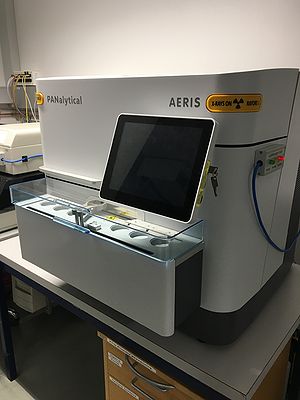Specific Process Knowledge/Characterization/XRD/XRD Powder
Feedback to this page: click here
Unless otherwise stated, this page is written by DTU Nanolab internal
All images and photos on this page belongs to DTU Nanolab
The XRD Powder setup
The "XRD powder" is an Aeris Research edition benchtop X-ray diffractometer from Malvern Panalytical. It is meant for phase analysis of powders, is easy to use, and offers the option of making measurements while heating the sample in a N2 atmosphere. The setup allows X-ray diffraction measurements in Bragg-Brentano mode (i.e., Theta-2Theta measurements where the incident and diffraction arms of the goniometer are coupled). We have a very limited selection of optics for this instrument, so there is little that the user can adjust.
Please contact the equipment responsible if you would like to mount the special sample holder for heating during the measurement.
The user manual(s), user APV(s), technical information, and contact information can be found in LabManager:
XRD Powder in LabManager - requires login
Process information
- Tips for choosing among the scan and hardware parameters you are allowed to change: XRD Powder measurement tips
- Malvern Panalytical has a large collection of webinars on XRD. You have to register to view them but the amount of email you receive afterwards is modest, so it's worth it in my opinion (Rebecca, July 2022). Some useful webinars include:
- Better XRD data quality with good sample preparation
- A beginner’s tutorial which also mentions sample preparation about half-way through and explains very briefly some of the issues that can arise from displaced samples, not having a thick enough sample layer, odd sized sample particles, etc.
Software
To adjust measurement parameters and analyze the data, you will need dedicated software which is described here: XRD Powder software
| Equipment | XRD Powder | |
|---|---|---|
| Purpose | Crystal structure analysis |
|
| X-ray generator |
Maximum rated output |
600 W |
|
Rated tube voltage |
40 kV | |
|
Rated tube current |
15 mA | |
|
Type |
Sealed tube | |
|
Target |
Cu | |
|
Focus size |
0.4 mm x 12 mm (Line) | |
| Goniometer |
Scanning mode |
incident / receiver coupled |
|
Goniomenter radius |
145 mm | |
|
Minimum step size |
0.001° (3.6") | |
|
Sample stage |
Fixed with rotation | |
| Optics | Incident side |
|
| Receiver side |
| |
| Substrates | Measurement temperature |
May be heated in N2 up to 500 °C |
| Substrate size |
Only for powders | |
| Allowed materials |
All materials have to be approved | |
